A Paipo Interview with Dave Jackman
Written reply to questions received May 2 & June 23, 2011 - Muriwai
Beach, New Zealand
and
Follow-Up Interview November 5, 2011 - Muriwai Beach, New Zealand
Questions by Bob Green
Dave grew up at Freshwater Beach, where in 1915, Duke Kahanamoku rode a
board he made from local sugar pine. Another piece of history is
located nearby, the legendary Queenscliff Bombora [Note
1]. In 1961, Dave was the first to ride this wave on a modern
surfboard. 1961 was also the year a "Who's Who" of Australian surfers
visited Hawaii. It was in Hawaii that Dave was exposed to paipo boards.
He carried the design he saw ridden at Waimea in his head for many
years. Once he built a paipo based on this Hawaiian design he rode his
board all around New Zealand. Dave described himself as still hooked on
riding a paipo.
|
1. Had you had seen
bellyboards being ridden before the 1956 U.S - Hawaiian team visit? If
so, when and where? What were the boards and surfing like?
Late 1940s, I saw crude paipos made by individuals, parallel sides
varnished ply wood. And, of course, there were the inflatable Surfoplanes.
Was this at Freshwater? Were the boards being ridden
to catch whitewater or were unbroken waves being surfed on them. If the
latter, presumably the surfers were wearing flippers.
These plywood bellyboards were mainly ridden in-shore in whitewater.
Folks made their own plyboards (no flippers).
Dave with two paipo he has made

Photo by Alan Ashworth -
www.slidemagazine.com.
2. You mentioned Tommy Zahn rode a paipo in 1956, on the
U.S - Hawaiian team visit. Do you know if this was Zahn's board and was
he riding it prone or standing up? Did any other team members have a
paipo?
I can clearly remember only Tom Zahn. He rode a twin fin balsa as in
your photos. He did ride some waves standing up. This was at Freshwater
Beach one afternoon in 1956.
3. In the Pacific Longboard interview you stated that
you built a copy of this board. Did you surf it much and what type of
wave did it go best in? I gather guys from the Manly SLSC rode similar
boards which they referred to as chest-boards (the wood board photos I
sent were of a board from Manly)?
The only balsa we could get was from Melbourne. My twin brother Mick
and myself got some very light cedar, glued it up, put twin fins on and
varnished it. It looked beautiful and went very well, prone or standing.
This style of
twin-finned balsa board built by Bill Clymer was similar to the one
made by Dave and his brother, and was ridden around Manly. The design
is similar to those designed by Wally Froiseth of Hawaii
|

|
|

|
Photos by Mike Brown.
Have you seen a board like the board below made by Joe
Quigg? Tim Guard, who was also on the 1956 US-Hawaii team visit to
Australia, left one similar to this at Freshwater after the trip.
I never took a lot of notice of the board but can distinctly remember
seeing it at Freshie. I never knew who owned it.
Joe Quigg
bellyboard.
|
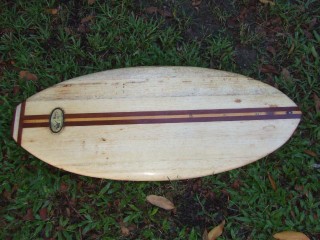
|
|
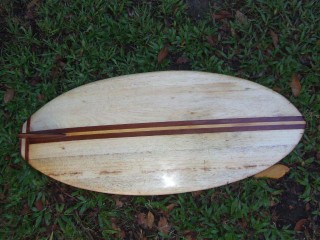
|
Photos courtesy of Gary Clist.
4. On your 1961 trip to Hawaii what do you recall of
Gordon Simpson's bellyboard ride at Waimea? [See Note 2.]
He told me that he was talked into going out - did he need much
persuading?
Gordon Simpson was a very good friend of mine and still is. I never saw
him ride Waimea.
5. I haven't been able to find out who the McDonnell
Douglas engineers were you saw out at Waimea. However, Val Valentine
has described Jim Growney and John Waidelich (the guys in the photos
that I sent) first surfing there on February 23, 1963, on the biggest
day of the 1962-1963 season [see Note 3]. Would you
have been in Hawaii then?
The first two men to ride Waimea were the two Americans. These were the
only men on these moulded plywood paipos. We were very impressed at the
time, in 1961. The first encounter with Waimea was in 1961, and were just plain plywood
boards, and no foam boarders. Never found out their names.
6. The board you did copy - is it the same board that
you are riding today - the one with the blue and red designs on them?
After shaping lots of boards I came back to Sydney with that shape in
my head. I didn't make the moulds until I moved to New Zealand.
When was this?
After my last trip to the Islands I finally moved to Auckland, NZ. That
was in 1963.
7. Regarding the board with the blue and red designs -- how
did you make the board? Was it shaped or made in a mould? What are the
basic dimensions and are there any special design features??
Yes, I did make the paipo with the blue and red design. I made a foam
plug and took female top and bottom moulds off. Kept it simple, no
different features.
Dave with John
Skirrow. John made the board with Dave.
|

|
|

|
Photos by Alan Ashworth.
Can you say a bit more about the construction of your
paipo? Are the boards ply or some composite
construction? What are the dimensions of the boards?
My moulded paipos were a very light gel coast, plus a light skin of
glass. Vacuumed foam core and another skin over the foam. I then spread
contact glue on the glass skin over the foam and a ready cut piece of
EVA foam and brought them together for trimming. The rope at the nose
was just a sling to carry the board.
Fifteen years ago, with my moulds completed, I built three and finished
them for a sales trip to Sydney. I started at Bondi shops going form
Southside to Northside. The shops sales people just stood there
bewildered. To cut a long story short I had to give up.
8. What type of wave does it go best in and where have
you surfed it?
The bigger the better and loved riding very hollow waves. To ride
Muriwai Beach was as good as any place. I live right on the beach.
9. Any waves or surfs on the paipo that you have had
that still stand out for you?
I have ridden many breaks in New Zealand. Once again hollow breaks.
10. What technique is involved in riding the board, e.g.,
taking the drop, turning and holding an edge in hollow waves?
I always enjoyed taking off and staying high on the face of the wave
where the power was.
11. Do you see any parallels between paipo riding
technique and bodysurfing?
There are some parallels but with that tough skin under your body the
extra speed is so good.
12. Rocky Hall used to ride a ply paipo around Winki-Pop
in the late-1960s, but I don't know if he rode this board in New
Zealand. Have you come across him?
Rocky Hall is from the South Island. I would say his board would have
been made by Val Valentine. Here at Murawai there are some guys who
have Val's original paipos. Funny - they never use them. Made of
plywood.
Rocky Hall
above Jeff Callagham - Winkipop and Bryan Hayden's ply board ridden at
Winkipop
|
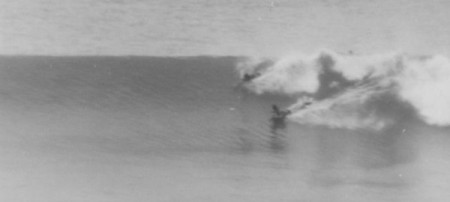
|
|
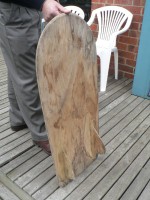
|
Photo by Kerrie Carson and board photo courtesy Bryan Hayden [see Note 4].
The board Rocky made was based on boards ridden on the
Gold Coast and later at Winkipop by Kit Carson and mates. The original
design was based on a board from Maroubra. The Maroubra guys knew Dick
Evans. I don't believe Val Valentine commercially made paipos until
1965. When did you think Bob Evans bought a Val Valentine board back to
Australia?
Well before paipos got to down-under and Rocky Hall, etc., there was a
time of no paipos. In fact, three guys working for Air NZ brought three
boards in and they were Val valentine boards.
13. Have you come across others riding bellyboard or
paipo in New Zealand (or elsewhere)? If so, who, when and where?
I'm sure the first paipo, i.e., a Val Valentine was brought to Australia
by Bob Evans and was used a lot by his brother Dick. Dick was a body
surfer and a member of Freshwater SLSC. You could always find Dick at
many Manly Warrigbah beaches [see Note 5]. Val bought
the rights to make the plain ply boards originally. Two of these are
still at Muriwai. Owners Erroll Lewton, Tony Butt and P.J. White, all
three from the 1960s. If you had seen the two Americans at Waimea -- the
speed across those walls -- they had me hooked.
1960s paipo board on display at Murriwai.
|
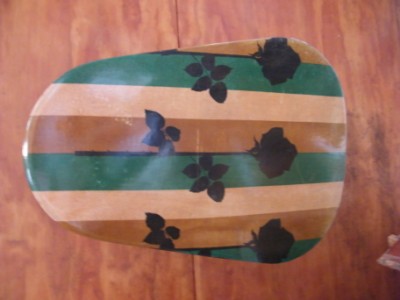
|
|
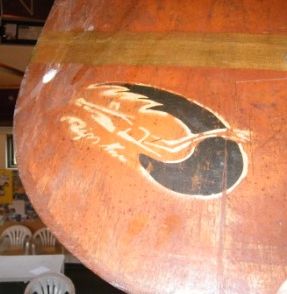
|
| "That
was Red Luton's board. I had it sent back from Australia. I had it here
in Australia before he died. I gave it to Neil Reid who used to be
president of Surf Life Saving New Zealand, who is a great friend of
mine. I said, "This is something of Red Luton's that I think the club
should cherish. Can you take it back and ask Dave Jackman to fix it up
for me". Dave took the old varnish off and re-did it. And they
put it up in the surf club as a tribute to Red Luton. I believe Peter
White made the board." Source: Lawson, Mike. (2012, January 29). 1960s
paipo board on display at Murriwai [E-mail to B. Green]. |
Photos courtesy of Pauline Butt.
14. What is the attraction of a paipo board for you?
I love my paipo and it is so convenient to throw into my car instead of
tying boards on roof racks. It can be ridden anywhere. I am still asked
a lot of, "What is this bat winged thing?"
Dave's board in profile
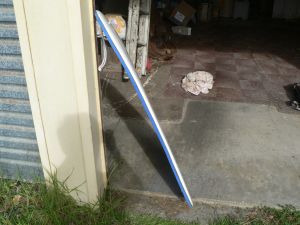
Photo by Bob Green.
November 5, 2011, interview and letter received November 24, 2011
1. How do you build you boards from the mould?
It's a normal fibreglass proceedure. All it is, a light gel coat goes
in and then a fine half ounce chopstrand mat and that's all it is. Then
I vacuum form in either foam or end grain balsa. With my little vacuum
pump I just suck the balsa down into some resin. It goes off. Because
it's got a slight camber in it and it wants to go in. All I do is take
off the excess off around the perimeter. It is an excess because it
rises up toward the rail. When I get it to that point, the glass I
leave a tiny lip all the way around the edge. Glass over the top with a
6-ounce cloth and then once that's gone off, F2 glue, then on goes the
EVA foam. Then I've got another mould that I put on the top of it.
Just get the jigsaw and cut off the excess.
One of the
moulds and a completed board
|
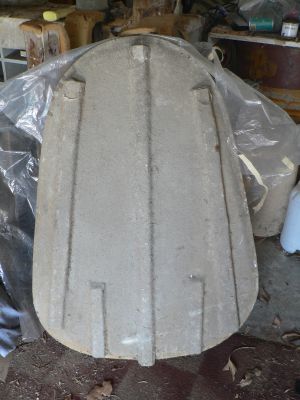
|
|

|
Photos by Bob Green.
What is the purpose of the EVA foam -- traction, buoyancy or
a cushion?
The EVA foam does do all of the things you have mentioned. The prime
idea was for buoyancy.
EVA deck and
foam mould
|
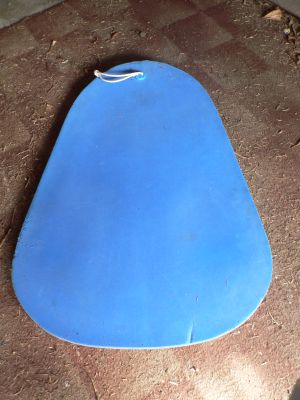
|
|
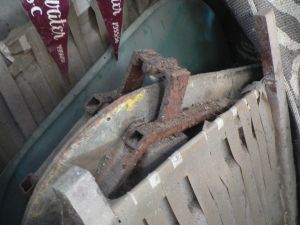
|
Photos by Bob Green.
2. What technqiue did you use to surf these boards?
The way I used to ride them was a bodysurfing type maneouver. In other
words you used to grab the leash that I put in the front there and then
lean into the wall of the wave and that arm was out, get it out of the
way of the wall.
So would it be extended past the nose of the board?
Slightly, just about past the nose - your knuckles would be. You're
leaning into it as the wave got steep, you'd grab the other side and
lift into it. If you got really fast, dumpy waves they are the best.
You get the speed, you can just rip into it.
If you find the right spot they just go.
No drag. You're not dragging your feet. You can llift your feet out of
the water, your feet there's drag. Fins on surfboards are drag. When I
ride that thing there (wave-ski) It's as loose as hell. No fin and you
can 360 it, rip and tear, all sorts of things.
3. Years ago I used to blow blanks. I had a couple
of moulds that I built. I soon got rid of them and got rid of breathing
Isocyanide gas. It's probably half my problem now I wouldn't mind
betting.
That's the simple method that I was doing. Plywood is still a good
medium to build them in, it really is, but it's heavier. You felt that,
it's as light as a hell.
A lifetime of creativity.

Photo by Bob Green.
You don't get that flotation though?
It kinda doesn't matter. Because all it is, is a planing surface for
your body, so you've got this smooth thing underneath you and you're
hiking. On a real good wave, hollow body surfing type of wave. It's
just an extension of body surfing, that's all.
The only time I find I need a little more bouyancy is
when there is a strong rip or a long paddle.
It's kicking all the way. No arm movement, you kick non-stop. It's good
for the stomach muscles.
You need a good set of legs too.
Oh shit yeah. You can't have the best of both worlds - so what you try
to do is avoid where the rip is somewhow or cut across it to where
there is no rip. Down here, this place can be very rippy. I believe the
beach is better on it's day. Some days it just goes and goes. All the
way down to where the patrol tower is. They're all left breaks here.
Everything is left here.
Looking north on a windy day
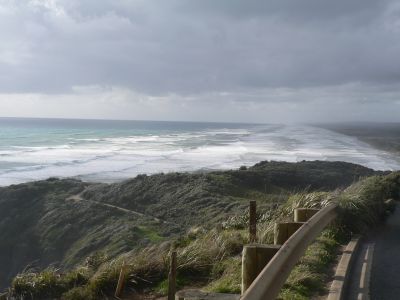
Photo by Bob Green.
4. You mentioned that you also made some hollow boards?
I did make a few hollow boards, so naturally this incorporated using the glass
deck mould. To achieve an internal joint I cut one ounce chopstrand,
applied resin, and rolled it into sausages around the circumference of the
hull. While wet I brought the deck down onto the resin wet sausages.
Also a stringer of sausages. This type of construction was left hollow,
with foam left out.
Dave's drawing of the construction process for a
hollow board.
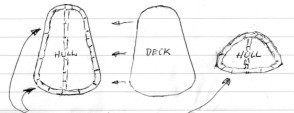
Drawing by Dave Jackman.
5. So are you still getting out there much?
I haven't been lately because of all these things I'm having cut out
and stitched up.
I'd heard you were a bit crook lately.
I have these three life threatening things - but I'm not sick.
Dave and Tony Butt. Dave's board (41" x 28") is a
little longer and narrower than Tony's Paipo Nui copy.
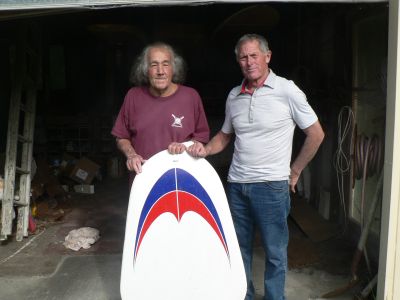
Photo by Bob Green.
Dave at Queenscliff Bombora, 1961
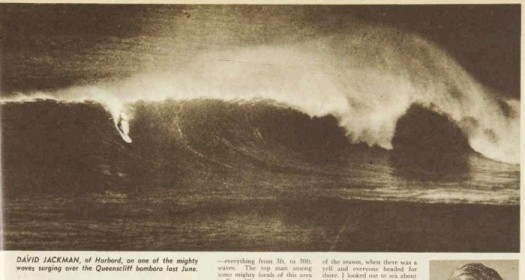
Author unknown. (1961, September 20). Teenage
Weekly Supplement. Australian Womens Weekly, 5. Via
Trove, the National Library of Australia's flagship discovery service
for the public.
|
Note 1: Details of Dave
Jackman's ride at the Queenscliff Bombora and Outside Pipeline can be
found in: James, Marcus (2011). A Waterman's Life: Dave Jackman.
Pacific Longboarder, 14(4), 54-59. Dave Jackman contributed a chapter to Pollard, Jack. (1963). The
Australian surfrider. Sydney: Murray. In his chapter, "Great Beaches,"
he noted on p. 100, "Newspaper reports made me appear as the first
surfer to ride that Queenscliff Bombora. I made no such claim. Claude
West, to name only one, had cracked it before I was born. I used the
short board, which made it easier for me. The difference was that I
paddled my board out, while Claude says he made his approach from a
surfboat. All credit to Claude West as he lacked the highly manageable
"plank" of today."
Note 2: Paipo interview with Gordon Simpson.
Note 3: See Valentine, Val.
(1965). Paipo Nui. International Surfing, 1(6), pages 50-52. See MyPaipoBoards.org. The background to the Val Valentine boards can also be found in a paipo
interview with Jim
Growney.
Note 4: See interviews with Kit
Carson, Jeff Callaghan, Bryan Hayden, Col Taylor and Michael Potter who
rode these small ply paipo in The
Paipo interviews.
Note 5: Ian Peden contacted
Dick Evans and advised on May 10, 2011, that Dick Evans couldn't recall
Bob bringing one back from Hawaii. A photo of Dick bodysurfing can be found in an interview with Ian.
Ian's interview includes a photo of friends with a ply board in New
Zealand. A contemporary of Ian is Dennis Markson who now lives in New
Zealand. See the Ian Peden Paipo Interview.
|
|




















